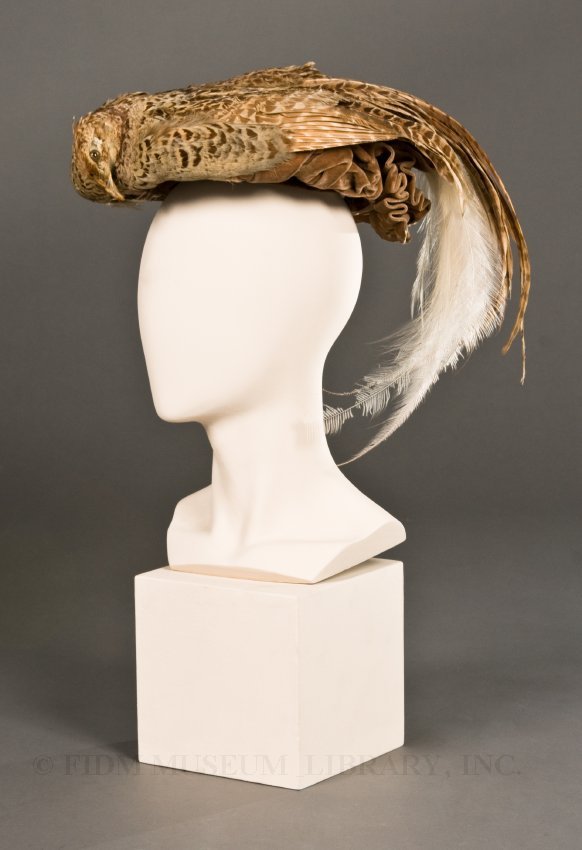Today, hats are worn primarily on celebratory or festive occasions, but in the 19th century, hats and bonnets were an essential element of every woman’s wardrobe. Beginning in the 1890s and continuing until about 1915, many hats were extremely large and served as an ideal canvas on which to display a variety of trimmings, feathers included. Egret, heron, hummingbird, pheasant, ostrich, seagull and peacock were all popular as sources of feathers, though milliners did not limit themselves to these birds alone. As you can see from the image below, creative milliners went far beyond the use of a single elegant plume. Sometimes, an entire wing was given pride of place, or even a full bird, as in the example below.
 Hat
Hat
c. 1905
Purchase
2008.25.17
Because of the high demand for bird plumage, an international network of feather suppliers and buyers developed. Egret farmers in Brazil and ostrich farmers in South Africa shipped their harvest to the fashion centers of London, Paris and New York. Some feathers were culled from birds destined for the dinner plate, though many birds were hunted only for their feathers. Because of the sustained and continuing demand for beautiful plumage, some bird populations began to decrease. Throughout the northeastern United States, plumage hunting during the 1880s and 1890s led to a marked decline in shorebirds such as gulls, terns and herons.*
The craze for feathers was not without controversy and the decline in bird populations did not go unnoticed. The Royal Society for the Protection of Birds formed in Britain in 1889 and the first incarnation of the Audubon Society emerged in the United States in 1886. Both of these organizations attempted to protect birds through legislation which prohibited the hunting of birds merely for their feathers. In the United States, bird advocates suggested creating a holiday called “Bird Day,” which was intended to celebrate the beauty of birds in their natural habitat.
In August of 1898, The Ladies’ Home Journal, the preeminent American fashion publication of its day, published an open letter purportedly written by 37 song-birds, begging the public to consider bird welfare. Appealing to the moral instincts of Journal readers, the letter pleads, “Will you make another [law], so that no one shall wear our feathers, so that no one will kill us to get them? We want them ourselves. Your pretty girls are pretty enough without them.” Despite their publication of this plea, The Ladies’ Home Journal did not support what they called “bird-millinery” legislation.
By about 1915, the most extreme varieties of bird and feather embellished hats had exited center stage, making way for hats with a much smaller profile. This change in fashions was perhaps partly due to efforts by conservationists, but it is equally likely that cultural changes brought about by World War I forced a shift to more practical headwear. By 1920, agreements between the Audubon Society and millinery
associations and legislation enacted by the United States government
had severely curtailed the type of feathers available for legal use in
fashion. Whatever the reason for this evolution in fashion, songbirds are surely relieved that they can live their lives in the trees, rather than sitting atop a fashionable hat.
*Doughty, Robin W. Feather Fashions and Bird Preservation. Berkeley: UC Press. 1975, p. 153.




Wow that is incredible. In so many ways.
Great new blog!
Thanks for your comment! I’ve been following the HLATC blog. The header image is beautiful! Good luck with the move…it’s such a huge project.
I am a fashion design Student and i would like u to know that SIX New Zealand fashion designers has invited by leading Designer down and feather duvet manufacturer Novadown to design a one-off statement garment using duvet feathers,down and fabric.According to Novadown, The result will be auctioned off on Trademe every two weeks from June to September, raising money to help dreams come true children with life threatening diseases through the Make a Wish Foundation .
Thanks for this interesting piece of information!
Here’s a link to some of the garments which have already been auctioned.
http://www.fashionz.co.nz/news/bid-for-novadown-designer-one-offs.html
Check out my hat…3 years of molting (collected peacock feather)16 glue sticks…and
6 days…it really is some thing else..